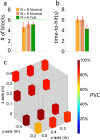Noninvasive Electroencephalogram Based Control of a Robotic Arm for Reach and Grasp Tasks
- PMID: 27966546
- PMCID: PMC5155290
- DOI: 10.1038/srep38565
Noninvasive Electroencephalogram Based Control of a Robotic Arm for Reach and Grasp Tasks
Erratum in
-
Author Correction: Noninvasive Electroencephalogram Based Control of a Robotic Arm for Reach and Grasp Tasks.Sci Rep. 2020 Apr 15;10(1):6627. doi: 10.1038/s41598-020-63070-z. Sci Rep. 2020. PMID: 32296101 Free PMC article.
Abstract
Brain-computer interface (BCI) technologies aim to provide a bridge between the human brain and external devices. Prior research using non-invasive BCI to control virtual objects, such as computer cursors and virtual helicopters, and real-world objects, such as wheelchairs and quadcopters, has demonstrated the promise of BCI technologies. However, controlling a robotic arm to complete reach-and-grasp tasks efficiently using non-invasive BCI has yet to be shown. In this study, we found that a group of 13 human subjects could willingly modulate brain activity to control a robotic arm with high accuracy for performing tasks requiring multiple degrees of freedom by combination of two sequential low dimensional controls. Subjects were able to effectively control reaching of the robotic arm through modulation of their brain rhythms within the span of only a few training sessions and maintained the ability to control the robotic arm over multiple months. Our results demonstrate the viability of human operation of prosthetic limbs using non-invasive BCI technology.
Figures








References
-
- He B., Gao S., Yuan H. & Wolpaw J. R. Brain–computer interfaces. In Neural Engineering (pp. 87–151). Springer: US, doi: 10.1007/978-1-4614-5227-0_2 (2013). - DOI
Publication types
Grants and funding
LinkOut - more resources
Full Text Sources
Other Literature Sources

